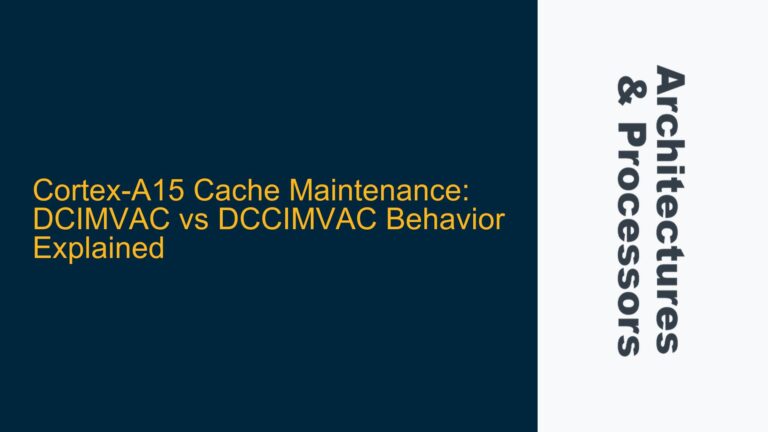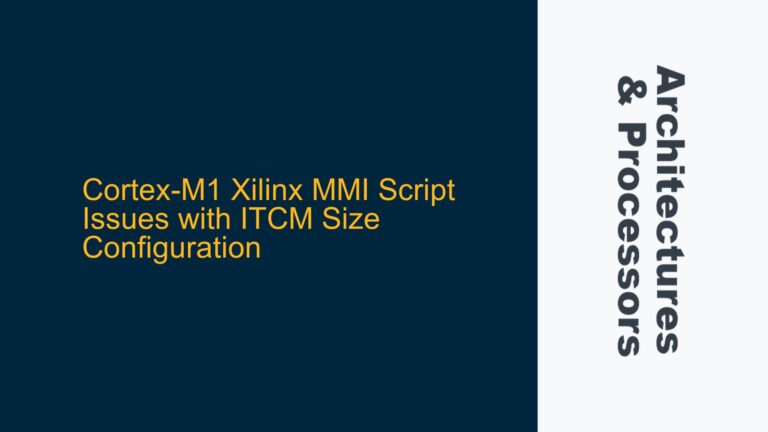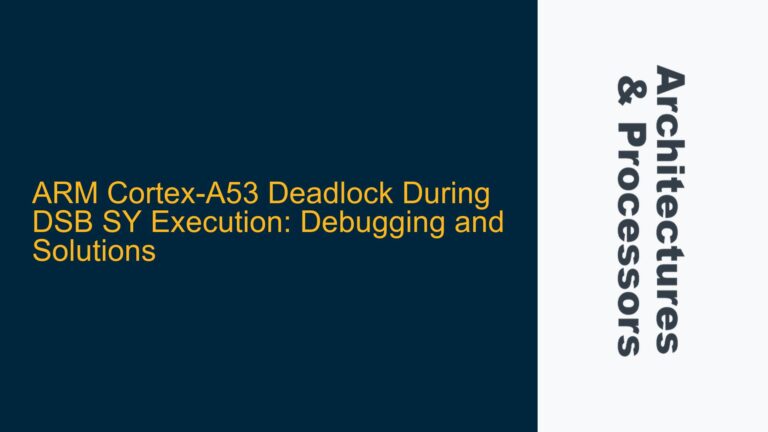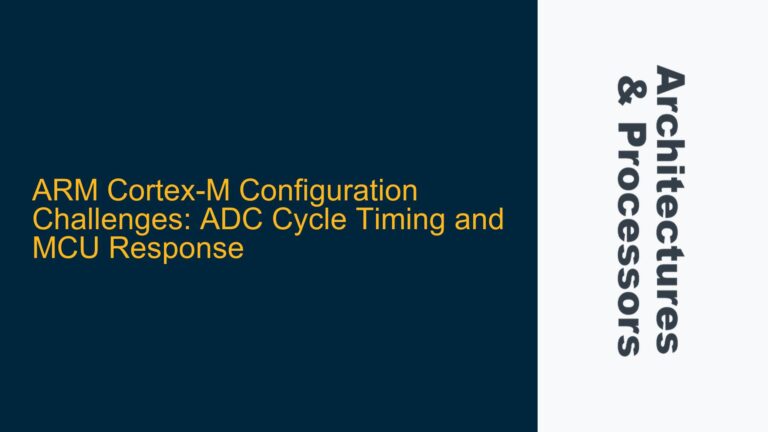ARM Cortex-A53 L1 and L2 Cache Invalidation Across Multiple Cores
In a multi-core ARM Cortex-A53 system, cache coherency is a critical aspect of ensuring data consistency across cores, especially when dealing with shared memory regions and DMA (Direct Memory Access) transfers. The primary issue arises when one core, such as Core0, invalidates a specific virtual address (VADDR) in its L1 and L2 caches after a DMA transfer completes. The question is whether other cores in the system will observe the correct data at the same VADDR after this invalidation. This scenario is particularly relevant in custom operating systems or bare-metal applications where manual cache management is required.
The ARM Cortex-A53 processor implements a cache coherency mechanism that ensures all cores see a consistent view of memory. However, this coherency is not automatic when dealing with manual cache maintenance operations like invalidations. The behavior depends on several factors, including the cache maintenance instructions used, the shareability domain settings, and the configuration of the system’s memory hierarchy.
When Core0 invalidates a cache line using an instruction like DC IVAC, xt, the invalidation is broadcast to all cores within the Inner and Outer Shareable domains. This means that the cache line is invalidated not only in Core0’s L1 and L2 caches but also in the corresponding caches of other cores. However, the data at the invalidated address must be fetched from the Point of Coherency (PoC), which could be the L3 cache (if present) or main memory. If the cache line was in a Modified state in any core’s cache, the invalidation could result in data loss unless proper synchronization mechanisms are in place.
Memory Barrier Omission and Cache Invalidation Timing
One of the primary causes of cache coherency issues in multi-core ARM systems is the omission of memory barriers or incorrect timing of cache maintenance operations. Memory barriers ensure that memory operations are completed in the correct order, preventing cores from accessing stale or inconsistent data. In the context of DMA transfers and cache invalidations, the absence of a Data Synchronization Barrier (DSB) or Data Memory Barrier (DMB) can lead to unpredictable behavior.
For example, if Core0 invalidates a cache line immediately after a DMA transfer without issuing a DSB, other cores might access the invalidated address before the invalidation operation is fully propagated across the system. This can result in cores reading stale data from their local caches. Similarly, if the DMA controller writes data to memory without proper cache synchronization, the data might not be visible to other cores even after the invalidation.
Another potential cause is the misconfiguration of the CPUECTLR.SMPEN bit, which controls whether the system operates in SMP (Symmetric Multi-Processing) mode. When SMPEN is set to 1, the system assumes that all cores share the same memory space and enforces cache coherency across cores. If this bit is not set correctly, cache maintenance operations might not be broadcast to other cores, leading to inconsistent data views.
The timing of cache invalidations relative to DMA transfers is also critical. If the invalidation occurs too early, before the DMA transfer completes, other cores might access the invalidated address and fetch incorrect data. Conversely, if the invalidation occurs too late, cores might continue to use stale data from their local caches.
Implementing Data Synchronization Barriers and Cache Management
To address cache coherency issues in multi-core ARM Cortex-A53 systems, it is essential to implement proper data synchronization barriers and cache management techniques. The following steps outline a robust approach to ensuring data consistency across cores during DMA transfers and cache invalidations.
Step 1: Ensure Proper Configuration of SMP Mode
Before performing any cache maintenance operations, verify that the CPUECTLR.SMPEN bit is set to 1. This ensures that the system operates in SMP mode and enforces cache coherency across all cores. The SMPEN bit can be configured during system initialization or through runtime configuration if supported by the hardware.
Step 2: Use Data Synchronization Barriers
After completing a DMA transfer and before invalidating the cache, issue a Data Synchronization Barrier (DSB) to ensure that all memory operations are completed. The DSB instruction prevents subsequent instructions from executing until all memory accesses before the barrier are completed. This ensures that the DMA data is fully written to memory before the cache invalidation occurs.
For example:
DSB SY
Step 3: Perform Cache Invalidation with Broadcast
Use the DC IVAC, xt instruction to invalidate the cache line at the specified address. This instruction broadcasts the invalidation to all cores within the Inner and Outer Shareable domains, ensuring that the cache line is invalidated across all relevant caches. The xt operand specifies the address to be invalidated.
For example:
DC IVAC, x0
Step 4: Issue Another Data Synchronization Barrier
After performing the cache invalidation, issue another DSB to ensure that the invalidation operation is completed before any subsequent memory accesses. This prevents cores from accessing the invalidated address before the invalidation is fully propagated.
For example:
DSB SY
Step 5: Verify Data Consistency
To verify that the data is consistent across all cores, perform a read operation from the invalidated address on each core and compare the results. If the data matches the expected DMA transfer result, the cache coherency mechanism is functioning correctly. If discrepancies are found, revisit the cache maintenance and synchronization steps to identify potential issues.
Step 6: Optimize Cache Management for Performance
While ensuring data consistency is critical, it is also important to optimize cache management for performance. Avoid unnecessary cache invalidations by tracking which cache lines are modified and only invalidating those lines when required. Use cache maintenance operations judiciously to minimize the performance overhead associated with cache coherency enforcement.
Example Implementation
The following code snippet demonstrates the complete process of ensuring cache coherency during a DMA transfer and cache invalidation on an ARM Cortex-A53 system:
// Step 1: Ensure SMP mode is enabled
MRS x0, CPUECTLR_EL1
ORR x0, x0, #(1 << 6) // Set SMPEN bit
MSR CPUECTLR_EL1, x0
// Step 2: Wait for DMA transfer to complete
// (Assuming DMA completion is signaled by a flag)
wait_for_dma_completion:
LDR x1, [x2] // Load DMA completion flag
CMP x1, #1
BNE wait_for_dma_completion
// Step 3: Issue Data Synchronization Barrier
DSB SY
// Step 4: Invalidate cache line at address 0x100000
MOV x0, #0x100000
DC IVAC, x0
// Step 5: Issue another Data Synchronization Barrier
DSB SY
// Step 6: Verify data consistency
LDR x3, [x0] // Load data from invalidated address
CMP x3, expected_value
BNE data_inconsistency_error
By following these steps, you can ensure that cache coherency is maintained across all cores in a multi-core ARM Cortex-A53 system, even during complex operations like DMA transfers and manual cache invalidations. Proper use of memory barriers, cache maintenance instructions, and synchronization mechanisms is key to achieving reliable and efficient system performance.






